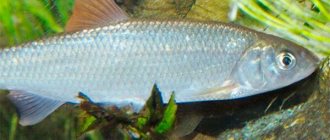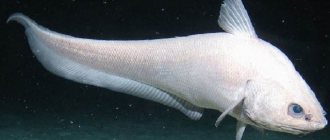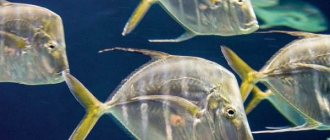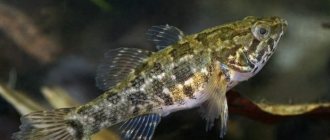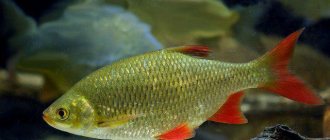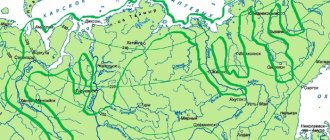Opening a new section on my blog, “Fishes of Amateur Fishing,” I decided to start with the first object of amateur fishing that came to mind—dace fish.
From the point of view of nutritionists, it does not have any extra natural calorie content, but I am sure that in any case, hardly anyone will refuse smoked, dried, lightly salted or fried spruce. The fish is very tasty. But before you cook it, you need to catch it, and for this you need to have at least a superficial understanding of its habitat and methods of catching.
What does dace fish look like, its subspecies, where is it found?
Dace is a fairly widespread fish. It lives in almost all rivers and other bodies of water with running water (lakes, reservoirs). Belongs to the carp family. There are about 17-20 subspecies in the post-Soviet space. These include:
- Siberian dace ( Leuciscus leuciscus baicalensis
), which will be discussed in particular in the article, since it is the most common subspecies. - Leuciscus leuciscus kirgisorum
. From the name you can immediately determine that the habitats are water bodies of Kyrgyzstan, and it is also widespread in Kazakhstan. - Common dace.
- Amursky.
- Issykul.
- Zeravshansky.
Externally, it has a slender, slender body with a somewhat narrow head and a small mouth. The scales are light, silvery-white. The color of the back is from greenish to brown. The abdominal, anal, and thoracic ones are colored reddish; the thoracic and caudal ones have a grayish tint.
Fish, depending on their territorial distribution, may have “races”. For example, on the Siberian Chulym River, two forms were identified that differ from each other not only in the color of their fins, have differences in size and body shape, but they even have their own ecological characteristics.
Prefers to live in bodies of water with clean, running water. Moderate currents, sandy, pebble and rocky bottoms are the optimal habitats for dace. Tries to avoid oxbow lakes, channels overgrown with vegetation with muddy bottom soil. The mouths of rivers and streams are a typical meeting place for anglers with this nice fish.
Despite its attraction to moderate current speeds, it also feels great in the stirrups. I remember how in the distant 80s, when the Angara River was being dammed for the construction of a hydroelectric power station, quite large and large quantities of dace were pulled onto the bottom right from behind the boulders, between which there was a powerful flow of water.
Dace is a schooling fish, often forming and moving in huge schools. It does not make long migrations across the reservoir; it lives sedentary. With the autumn cooling of the water, it spends most of its time in deep areas. With the arrival of winter, when the reservoirs are covered with ice, they move to wintering pits.
Even before the rivers open, it begins to make seasonal movements into small tributaries, where it spawns.
About dace spawning
Depending on climatic conditions, it reaches sexual maturity in different ways:
- In northern latitudes - at the 6th year of life, with a body size of 16 - 17 cm with a weight of 70 - 75 grams.
- In the southern regions - at 2-3 years of life with a body length of 10-15 cm.
Spawning begins when the water warms up to 6.5 - 7.5 degrees and continues until July (for the north). The eggs (up to 2 mm in diameter) are spawned on the ground, less often on aquatic vegetation. The number of eggs ranges from 2.4 to 19 thousand.
Having spawned eggs, they remain in the spawning areas for the entire summer and only in the fall do they roll into large rivers again.
At the age of 12 - 13 years it is capable of reaching a length of 24 - 25 cm with a weight of 250 grams. But such large individuals are rare. Typically, anglers catch dace with a body weight of up to 100 grams and a length of about 18 cm.
It feeds on flying and aquatic invertebrates - caddisflies, mayflies, chirominids and small mollusks. The diet also includes aquatic vegetation - green, filamentous algae.
During the spawning period, it happily eats caviar, and later fish larvae. Having such a wide diet, it is a significant food competitor for many other inhabitants of the reservoir.
Life and habits of the dace
Dace lifestyle
Considering the food preferences of the dace, it can be classified as a conditionally predatory fish, so its behavior in the water is appropriate - waiting in the stream behind natural shelters (rocks, ground “ribs”, underwater trees, etc.) and attacking animal food floating past or falling into the water (insects, larvae, crustaceans...), or hunting for insects flying over the water.
Dace live in sedentary, large flocks, especially yearlings, two- and three-year-olds. Only old and large individuals swim alone or in a small school of 2-5 fish.
In summer
After spring spawning, the dace fish moves to flowing, deep sections of the river with moderate or strong currents, where it stays in the bottom layers for most of the day, and spends almost the entire summer like this. Dace rise to the surface only early in the morning and evening, as well as on moonlit and “white” summer nights to hunt insects swarming above the water.
Depending on weather conditions, dace can go out from deep sections of the river into riffles and reaches in search of food, and when they are full, they roll back.
Autumn and winter
In autumn, dace stay at depths of 2-4 meters, and with colder weather and the onset of winter they slide into pits. Here they gather in large and sedentary flocks - this is how they spend the entire winter, practically do not feed and, accordingly, do not fall into the catches of fishermen.
Only during prolonged thaws can they weakly move around the reservoir in search of food. In February-March, schools of fish “come to life” on the eve of spawning and emerge from their wintering pits.
Dace spawning
Dace begins to spawn when the water heats up to more than 5 degrees. This is usually March-April, depending on weather conditions and habitat.
Unlike bleak, dace spawns at a time, and not in portions; usually 3-5 days are enough for fish to spawn.
As the ice breaks up on the river, the dace fish rises higher up the river and in the upper reaches enters channels and small streams, where it begins to spawn. Females spawn on underwater rocks and soil, and in rare cases, on underwater plants, which at this time are just beginning to emerge from the soil.
The fish reach sexual maturity at 3 years of age with a length of more than 10-13 cm. Three-year-old females spawn from 3 to 12 thousand eggs, and the older and longer the female, the greater her fertility. Dace eggs are white and large - up to 2 mm in diameter.
The hatched fry swim near the shore, hiding in the coastal vegetation. When they reach a body size of 4-5 cm, they swim away and stay in riffles and shallow depths.
Up to 2 years old, dace grow quickly, adding 15 - 20 or more grams annually. By the age of three, their weight is usually from 30 to 50 grams, and further growth slows down significantly.
Single individuals aged 8-10 years with a live weight of 350-500 grams grow up to 30 cm.
Dace nutrition
Mayflies emerge, dace fatten up.
The diet of dace consists mainly of a variety of natural animal food, less often plant food. In the warm season it is mainly:
- insects that live in grass and bushes, trees near water and accidentally fall into it - grasshoppers, beetles, dragonflies, butterflies and other creeping creatures;
- flying adult insects and in the larval stage that live in water - flies, midges, mayflies, mosquitoes, goose, bloodworms, shitiki, etc.
In winter and during the cold season, the basis of nutrition is aquatic zooplankton: crustaceans, as well as benthic organisms - larvae, worms, crustaceans, rotifers, daphnia and others.
In the spring, during high water in the flooded meadows of the coastal zone, dace eat the above-ground and underground “inhabitants” washed out by the water - worms and insects - worms, beetles, larvae, etc.
During the spawning period, they actively feed on caviar, which harms other species of river fish.
Methods for catching dace
Catching dace is very exciting. I especially like to catch it at the end of winter, when the Angara has not yet opened, and schools of fish are already beginning to enter the tributaries and lakes that share the river. Sometimes the line with the jig has not yet reached its full length, but a silver lad is already sitting on the hook. This is due not only to the desire to eat, but also to the presence of competition in a large concentration of fish. As they say: “In a big family...”.
Dace can be caught using almost all types of amateur gear:
- Float rod.
- Donka.
- Winter fishing rod.
- Spinning.
- Fly fishing.
In places where fish is an important diet, dace are caught with nets. The caught fish is mixed with snow in 200 liter barrels and left right on the street. Snow prevents bodies from sticking together and protects against moisture loss. When necessary, simply pick with a knife as much as necessary. The taste qualities are not lost - the dace is fresh and tasty all winter.
So, as you can see, virtually the entire arsenal of amateur fishing gear is used to catch dace. But if everything is clear with fishing rods, then spinning fishing for this far from large fish is the pinnacle of a fisherman’s skill. Sorry, I didn’t want to offend anyone, but I think ultralight fishing is truly the height of skill.
There were cases when it was possible to completely accidentally hook a spruce tree near a riffle on a 5-gram spoon or wobbler (for example, a Jackall Chubby 38F, or simply “chubby”), but these were only accompanying bites. At that time I was catching perch.
So there is no end to work in this direction. Apparently, when I retire, I won’t be able to pull pikes anymore - I’ll switch to a super-light spinning rod. I will catch fir trees.
Bait and groundbait
There is nothing strange in the fact that the preferences of the dace vary according to the seasons of the year.
- In autumn and winter, the best results are obtained by maggots, small bark beetles, gammarus, and occasionally chopped earthworms.
- In the spring, from the hole I fish for caught caddis flies, maggots, and an ice cutter.
- In summer, worm, grasshopper, gadfly.
That is, it turns out that as bait I use the “animal” that is convenient to get or catch.
In the spring, on the last ice, reelless jigs give excellent results. For example, my beloved “witch”. In winter, if you manage to find an active flock, the mothless moth is also able to please you. However, it is preferable to attract and stop a moving flock. and for this you have to sacrifice the excitement of fishing with iron decorated with cambrics and resort to baits and bait.
The bait for catching dace often looks extremely miserable, but is no less effective than if you had to stand in the kitchen over the stove with various odorous ingredients.
Compound:
- Crushed roasted sunflower seeds.
- Ground rye crackers.
- Boiled barley or millet porridge.
- For decency, you can also add a scented composition - hemp oil or a little fir. The latter works only in minute proportions. The dace avoids strong-smelling masses. But you can lose your jig because of an interested burbot.
Adding crushed maggots, bloodworms, and worms to the bait is important when the bite is really bad. In addition, any livestock on the menu is welcome.
I don’t throw bait into the hole. I use a homemade feeder. You lower it to the bottom, dump it out and catch it.
Dace is not known for being particularly picky about food. he devolves the offered porridge with enviable appetite. Every spring the same outrage happens on the ice. all anglers feed their holes. As a result, you catch dace without even feeding it, and when you take the caught fish off the hook, porridge comes out of its mouth. They are still piglets.
Features of baits for dace
Content
Dace is a rather interesting species of vertebrate. The fish is distinguished by its agility and uncompromising resistance. But at the same time, the fish is not too picky, which makes the fisherman’s task easier. In this regard, do-it-yourself bait for dace should be simple and effective. Once in the water, the bait instantly attracts the attention of the fish and the latter has absolutely no need for exquisite “dishes”.
It is important to understand that complementary foods are not complete feeding, so the product should be offered to the dace along with clay or soil. The approximate amount of nutrients should be 30-40%, the rest is just an addition to the total mass.
The bait mixture for dace must be mixed with soil
The simplest white bread is considered a win-win option for bait. Fish loves the aromatic smell and taste of baked goods. It is enough just to soften the product in water and make balls out of it (or stick small pebbles). You need to throw the bait to the point where you want to concentrate the fish in order to easily catch it in the future.
Some fishermen mix ground crackers with seeds and store the complementary food in dry form, after which they dilute the mixture with water with the addition of earth/clay on site.
After arriving and settling at the fishing site, you need to throw in complementary food in the amount of 4-6 balls made the size of an ordinary apple. You should periodically throw the prepared coma into the water. It is very important to try to keep the fish in the desired location for as long as possible. It is enough to add chopped worms and bloodworms to the prepared complementary food. It is also possible to enhance the aroma with cocoa.
Read more
What is a nailball jig?
